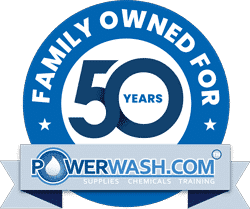- Home
- /
- PowerWash Industry
- /
- Hydrofluoric Acid First Aid
Subscribe To Our Newsletter
Stay in the know on the latest products, deals, events, tips & tricks.
Social Media
Hydrofluoric Acid First Aid
This article originally appeared in the January/February 2000 issue of Chemical Health & Safety. Reprinted with permission.
October 22, 1999: Robert Belk, a 48-year-old business owner, died at Grady Memorial Hospital after an exposure to hydrofluoric acid. Belk owned a company called Chemical Packaging near Atlanta, GA, which produced solutions for high-pressure washing. At the time of the accident, Belk was mixing a solution when a hose slipped, saturating his clothes with 70% hydrofluoric acid. He hosed off with water, but rather than have his secretary call the paramedics, he drove himself to the hospital. Burns were found on both lower legs and his left arm, but it was the HF that went through his skin that caused his death the following day from respiratory and heart failure.
The above accident illustrates a dire consequence of working with hydrofluoric acid without an awareness of its extreme hazards and with a lack of preparedness. From the numerous queries I personally have received after publication of my first paper in 1998, I conclude that there are still many more who could use information. And from a recent spate of inquiries on the safety list serve, it appears that many have not established a protocol for HF exposure or heard of the current recommended methods of treatment. In this article, I want to discuss:
I. Review of HF Hazards
II. Emergency Procedures
III. Treatments
IV. 5 vs. 15 Minutes of Irrigation
V. Current Status of Hexafluorine
I. Review of HF Hazards
Hydrofluoric acid (CAS 7664-39-3) is a high-volume chemical used in at least eight industries (see Fig. 1). It had a production rate of 375,000 tons in 1998, and its U.S. demand is estimated to be 400,000 tons in 2002. It is considered more hazardous than most chemicals in five out of six ranking systems; and it is ranked as one of the most hazardous compounds (worst 10%) to human health. Ray Campbell, REA, CCHO, at Varian, Inc., described his HF injury as “the most painful, disabling, scarring, long-term injury I have ever seen, and I am a Vietnam veteran.” Concentrated HF covering 2% of the body can be fatal.
HF is a colorless, fuming liquid or gas with strong, irritating odor. In concentrated forms it is a strong protonic acid, whereas dilute solutions are weak acids (pKa = 3) that remain relatively non-ionized but can penetrate the stratum corneum (the tough waterproof outer skin layer of dead cells) and penetrate deep into tissue layers. Once absorbed, HF dissociates rapidly at the physiological pH of 7.4.
HF ® H+ + F-
Toxic systemic effects occur when the electron-hungry fluoride ion penetrates and migrates into tissue to bind primarily with calcium, although binding to magnesium, sodium and potassium can also occur.
Ca2+ + 2F- ® CaF2
Mg2+ + 2F- ® MgF2
Without enough calcium (hypocalcemia) and magnesium (hypomagnesia), nerves fail and cell membranes collapse. In addition, excess potassium (hyperkalemia) can occur, which can lead to life-threatening cardiac arrythmias (ventricular fibrillation). The adverse effects can progress for several days after exposure.
Surface involvement of weak solutions is minimal and may even be absent. Burns to the fingers and nail beds may leave the overlying nails intact. An insidious hazard is the fact that dilute solutions are indistinguishable from water.
The time to onset of symptoms is related to the concentration of the HF:
• At concentrations greater than 50%: immediate burns appear with rapid destruction of tissue as noted by a whitish discoloration, usually proceeding to blisters, accompanied by severe pain. The pain is typically described as “deep,” “burning” or “throbbing” and is often out of proportion to apparent skin involvement.
• At concentrations between 20 and 50%: burns can be delayed one to eight hours.
• At concentrations less than 20%: painful erythema may be delayed for up to 24 hours. Redness, burning or pain may not show up until several minutes or even hours have elapsed. Thus, the surface area of the burn is not predictive of effects.
II. Emergency Procedures
Standard first aid for most corrosives is to flush the exposed area with water for fifteen minutes. Then treatment by a professional can be administered. However, because of the dire consequences of HF exposures, the following first aid is recommended (based mainly on procedures used by AlliedSignal6).
A. Skin Contact
1. Immediately (within seconds) shower or flush with plenty of water.
2. Remove all clothing while in the shower. (Remove goggles last and double-bag contaminated clothes.)
3. If 2.5% calcium gluconate gel or 0.13% benzalkonium chloride is available, rinsing may be limited to five minutes [this is sufficient time to effectively remove HF from the skin; additional flushing time is unnecessary and will delay further treatment]. If neither neutralizing agent is on hand, continue to flush until medical help is available.
4. Continue with either step a. or b.
a. Apply calcium gluconate gel (2.5%) while wearing impervious gloves. Massage the gel promptly and repeatedly into burned area until pain is relieved. If pain does not subside within 20 to 30 minutes, injections of 5% calcium gluconate by a professional may be needed.
b. Immerse affected area in iced 0.13% benzalkonium chloride (Zephiran). Use ice cubes, not shaved ice, in order to prevent frostbite. If immersion is not practical, use towels soaked with iced 0.13 % benzalkonium chloride as compresses for the burned area. Change compresses every two to four minutes. Continue until pain is relieved. (This may require hours.)
5. Get medical help.
B. Breathing Vapor
1. Immediately get to fresh air.
2. Call or have someone call a physician.
3. Breathe 100% oxygen (10 to 12 L/min flow rate) as soon as possible.
4. Trained personnel should provide calcium gluconate (2.5%) by nebulizer.
5. Get medical attention.
C. Ingestion
1. Drink large amounts of water. Do not induce vomiting or administer activated charcoal.
2. Drink several glasses of milk or several ounces of Milk of Magnesia, Mylanta, Maalox or similar product, or eat up to 30 Tums, Caltrate or other antacid tablet.
3. Get immediate medical attention.
D. Eye Contact
Because of the ability of HF to penetrate deep into tissue, exposure of HF solution or vapor to the eye can produce more extensive damage than that of other acids in similar concentrations. For example, hydrochloric acid damages only the superficial structures of the eye because its penetration is limited by a precipitated protein barrier.5 In the case of HF, immediate action should be taken with initial flushing and then treatment with sterile 1% calcium gluconate solution. For details, see the inset by Bernard Blais, M.D.
III. Treatments
Calcium gluconate is the preferred treatment of choice for minor HF exposure for the following reasons:
• It is easy to use.
• It can be self-administered or applied by personnel trained in first aid care.
• It can be applied immediately as soon as the burn is suspected.
• It is painless to apply.
• It produces no risk of increasing tension in the tissues.
• It can be used topically, opthalmically, by infiltration and inhalation.
• It reduces the risk of hypocalcemia.
• No sophisticated equipment is necessary.
Pharmascience Inc. is the main supplier of calcium gluconate and can be contacted at 8400 Darnley Rd., Montreal, Quebec strongT 1M4, Canada. In the U.S., the company has a distributor at 175 Rano St., Buffalo, NY 14207 (800-207-4477, orders; 800-363-8805, technical information).
A. Mixing Your Own Solutions
This method can be considerably cheaper or a local pharmacy can make up a solution.
1. Topical Gel (2.5%). Mix one 10-mL ampule (10%) per ounce of surgical gel (K-Y Lubricating Jelly; Johnson and Johnson). The gel must be kept above 40°F. Do not freeze.
The latest DuPont MSDS (Nov 1998) supplies another formulation as well: Mix 3.5 g of USP calcium gluconate powder with a 5-oz. tube of surgical water-soluble lubricant (e.g., K-Y Lubricating Jelly).
2. Calcium Gluconate Solutions for Topical Injections. Mix one 10-mL ampule (10%) with an equal amount of saline solution to give a 5% calcium gluconate concentrate.
3. Nebulizer. Mix one 10-mL ampule (10%) per 30 mL of saline solution to give a 2.5% calcium gluconate solution.
4. Eye Wash. Mix one 10-mL ampule (10%) per 90 mL of saline to get a 1% calcium gluconate solution. If you take 100 mL out of a 1000-mL bag of normal saline and put in 100 mL of calcium gluconate, you will have the proper mixture.
Note: The shelf-life for all mixtures has not been determined, but a periodic replacement period should be established; the recommendation on the DuPont MSDS is six months. If the ingredients are stored separately until needed, the shelf-life is less of a concern.
Be aware that even following emergency treatment with calcium gluconate, delayed life-threatening burns can still occur. Follow up treatment at a medical facility is necessary. It is wise to warn the hospital of your intentions to bring folks to them for HF burn treatment and to make sure that they are informed of its specific treatment.
B. Benzalkonium Chloride
(Zephiran Solution)
This product can be obtained from Sanofi Inc., 90 Park Ave., New York, NY 10016 (800-446-6267). It is available in gallon containers as a 1:750 (0.13%) solution. The material has a limited shelf life and should be stored in light-resistant containers. A 17% solution is also available but should only be diluted by a qualified individual. Since benzalkonium chloride is a nonprescription drug, it should be available through most local pharmacies. They can obtain it from pharmaceutical wholesale distributors. Assorted basins should be kept on hand for immersions.
IV. Five vs. 15 Minutes of Irrigation
After my first paper was published, a letter to the editor was published in the Jan./Feb. 1999 issue of Chemical Health & Safety entitled, “Another viewpoint on the treatment of HF skin exposure.” The purpose of this letter was to “provide an interpretation of these different procedures and offer a practical response for HF skin procedure.” Points brought out follow:
• It is straightforward to train employees in a single emergency response treatment (i.e., the common 15-minute wash protocol).
• Recommendations in MSDSs are inconsistent.
• There is a real possibility that a confused employee will attempt to apply HF treatment to another acid, (e.g., HCl).
• Community-involvement programs stress communication with industrial users of HF and hospitals.
All the above are valid statements, but we are faced with a dilemma when considering DuPont’s claim, “Flushing with water thoroughly for five-minutes is sufficient to effectively remove HF from skin. Additional flushing time is unnecessary and will delay further treatment. Although flushing is effective in removing surface acid, it does not affect the F- that may have already penetrated.”
Will an exception to the rule for HF cause confusion? The solution is, of course, to have a plan in effect ahead of time and to provide training to implement that plan. All potentially exposed personnel should be trained in first-aid care for HF burns before beginning work with HF. Calcium gluconate gel should be readily accessible in areas where HF exposure potential exists.
DuPont provides all its potentially exposed personnel with a 3″ x 5″ booklet and a 2.25″ x 3.75″ card that is easily carried on their persons. These are routinely provided free of charge to companies purchasing HF and to anyone who requests a single copy. (Call 800-441-9408.)
My contact at DuPont informed me that the five-minute wash procedure began in 1990 and since that time at least 75% (it might be as high as 98%) of companies using anhydrous HF have adopted the five-minute wash. Further, he tells me that the five-minute wash is being applied to other water-soluble substances such as hydrochloric acid and chlorine. For skin contact, the DuPont MSDSs for hydrochloric acid and chlorine state, “Flush the skin thoroughly with water at least five minutes.” Preliminary tests show that the five-minute time frame is effective in many cases; this is especially fortuitous in cold areas where a 15-minute cold shower wreaks its own hazards.
And consider this! In 1998, Pharmascience introduced a new product, a sterile 2.5% isotonic calcium gluconate wash packaged in a plastic container (480mL). In the event of an exposure, the solution was to be applied immediately to affected areas until thoroughly washed. It was claimed that the wash removed more HF than a pure water wash and significantly reduced the quantity of HF that penetrated the skin. After washing, calcium gluconate gel was to be applied repeatedly while seeking medical attention. Evidently, HF users weren’t ready for this innovation and, as of August 6, 1999, the wash was no longer available.
V. Current Status of Hexafluorine
At the 1998 spring meeting of the Semiconductor Safety Association, Alan Hall, M.D., delivered a paper 8 that presented impressive results about the use of Hexafluorine, a proprietary product manufactured by Laboratoire PREVOR in France. This product is claimed to be an amphoteric, hypertonic, chelating agent specifically designed to detoxify hydrofluoric acid. It has chemical bond energy greater than that of eye/skin receptors and does not produce a significant exothermic reaction with release of heat that could further damage exposed tissue. In addition, it is claimed to be safe to use in the eyes. Hall describes five cases in his paper. Two of the cases follow:
1. A worker fell into a bath containing 1505 L of water, 30 L of concentrated hydrochloric acid and 233 L of 59% HF (calculated bath concentration — 9.2% HF), immersing his entire body and face. Hexafluorine, as well as a regular water eyewash, was immediately used for decontamination by coworkers. Only minor burns developed on the back and abdomen. There was a significant corneal burn of the left eye, but the right eye remained normal.
2. At a facility using a chemical dipping bath containing nitric acid and HF for producing stainless steel for construction and machine tools, a worker sustained an eye splash with 38% HF. He rinsed his eye immediately with Hexafluorine and did not develop any eye injury, returning to work the next day.
Experimental animal data on rats and rabbits as well as in vitro data are compelling. One such case is shown in Fig. 2. To simulate the effects of decontamination without flushing, 10 mL of 0.1 N HF (0.2%) was placed in a beaker and either water, 10% calcium gluconate or Hexafluorine was added. The pH and the pF (pF = negative logarithm of the fluoride ion concentration) were measured. As noted, water had little effect. Both calcium gluconate and Hexafluorine absorbed or neutralized H+, although Hexafluorine bound the hydrogen ion 100 times greater than calcium gluconate. The final pH for Hexafluorine was 6.5 vs. 4.5 (still acidic) for calcium gluconate.
I recently spoke with Dr. Hall, one of the authors of the 1998 paper on Hexafluorine, who has been hired as a consultant for PREVOR. He was very skeptical about the product at the beginning, but new incidents of 11 exposed workers at Mannesmann AG (headquartered in Dusseldorf, Germany) have shown the effectiveness of the product. These case studies were presented at the Semiconductor Safety Association 2000 Spring Meeting and published.
Hexafluorine is being widely used in France and Germany. Ireland, Italy, Sweden and the United Kingdom are giving serious consideration to its use. In the U.S., PREVOR is actively seeking FDA approval, armed with the new compelling data from Germany. One “sticky” issue is whether the product should be considered a drug or, preferably, a medical device (as it is in Europe).
Conclusion
Because HF is a unique acid and its emergency treatment is specialized and different from that of other inorganic acids, all exposed and potentially exposed personnel should be made familiar with its properties and hazards and trained ahead of time to deal with emergency situations. In the case of the HF fatality mentioned in the introductory news report, the victim evidently was not aware of the internal damage that the fluoride ion could inflict. Protocols should be set up, appropriate supplies should be on hand and arrangements should be made with nearby hospitals and professionals because not all physicians may be aware of the unique treatments. In addition, one should always try to keep up to date to learn of new innovations in safety, especially when working with nasty chemicals, such as HF, and then institute those changes if they can save lives. Even if you’ve already converted to a five-minute rinse and have calcium gluconate on hand, don’t get complacent! New and better changes may be coming. Stay on top of safety!
Acknowledgements
I want to thank Dr. Bernard Blais for his contribution to this article and acknowledge Allied and DuPont for their valuable comments, assistance and generosity in sharing information.
References
1. Kelley, S. The Gwinnett Daily Post, Oct. 23, 1999, p.1. Web site: http://www.gwinnetdailypost.com/gdp10231999/fpals2-gdp.htm.
2. Segal, E.B. “First Aid for a Unique Acid: HF,” Chem. Health Saf. 1998, 5, 25-28. Also on the Web: http://dchas.cehs.siu.edu/Magazine/hf.
3. “Chemical Market Reporter,” Chemical Profile of Hydrofluoric Acid, Oct. 1999. Schnell Publishing, New York, NY.
4. Chemical Scoreboard, Environmental Defense Fund, New York, NY, 1999.
5. Caravati, E.M., Am. J. Emerg. Med. 1988, 6(2), 143.
6. “Recommended Medical Treatment for Hydrofluoric Acid Exposure,” Dec. 1998, AlliedSignal Inc., P.O. Box 1053, 101 Columbia Rd., Morristown, NJ 07962-1053. This booklet can be obtained at no charge by calling 800-622-5002 or faxing your request to 973-455-6141. For more information, check out AlliedSignal’s Web site at http://www.specialtychem.com/ha/.
7. Langerman, N. Chem. Health Saf. 1999, 6(1), 5.
8. Hall, A. H.; Blomet, J.: Gross, M.: Nehles, J. “Hexafluorine® for Emergency Decontamination of Hydrofluoric Acid (HF) Eye/Skin Splashes.” Presented at the Semiconductor Safety Association Meeting, San Diego, CA, March 1999. Funded by Laboratoire PREVOR, Moulin de Verville, Valmondois, France.
Eileen B. Segal is a private consultant in the field of chemical health and safety and in technical editing. She was an analytical chemist for DuPont and the GAF Corp., and for the past 19 years has conducted seminars in health and safety throughout the United States and Canada as part of the J.T. Baker Office of Training Services.
Tables:
Hydrofluoric Acid
CAS No. 7664-39-3
UN 1052 (anhydrous)
UN 1790 (solution)
Synonyms: hydrogen fluoride, fluoric acid, hydrofluoride, fluorine monohydride
OSHA PEL 3 ppm
Description: colorless gas or fuming liquid
Disagreeable, pungent odor at less than 1 ppm
Irritation of eyes and throat at 3 ppm
Molecular weight: 20.0 daltons
Boiling point 68°F (20°C) at 760 mmHg
Specific gravity 0.99 at 19°F (-7°C)
Vapor pressure 400 mmHg (34°F)
Vapor density 0.7 (air=1)
Miscible with water with release of heat
Nonflammable
Industry Use
Electroplating Acid Metal Cleaners — Oxide Removers
Etching Glass Etching and Frosting
Flotation Agents Depressants — Nonsulfide Ores
Integrated Iron and Steel Manufacturing Pickling Acids
Laboratory Chemicals Acids, Other Chemicals (non-salts)
Oil Refineries Catalyst to Produce High-Octane Fuel Additives
Refrigeration Manufacture of Fluorocarbons
Semiconductors Wet Chemical Etching
Home Use: Air conditioning unit coil cleaners; aluminum automotive wheel cleaners; chrome, brass and crystal cleaners; masonry cleaners; rust stain remover; truck and commercial car washing compounds; water spot remover.
More information about the safety of hydrofluoric acid can be found below at Cleaner Times.
A-400 Hydroflouric Acid can also be found at PowerWash.com
Saftey apparel can be found at PowerWash.com
Share This Post
More To Explore
Beat the Heat: Summer Safety Tips for Power Washing Professionals
Protect Your Crew. Protect Your Equipment. Protect Your Business. When the summer sun blazes, pressure washing jobs don’t stop—but the ...
Soft Wash Additive That Smells Amazing? Meet Fresh Wash
Freshen Up Every Wash Soft washing is all about precision, power, and presentation — and nothing completes a job like ...
Mastering the Art of Pressure Washing: Key Insights on Surface Cleaners
For professionals in the pressure washing industry, a surface cleaner is an indispensable tool, particularly for those who specialize in ...
The Wrangler™ Chemical Sprayer: The Ultimate Tool for Professional Cleaning Applications
For commercial cleaners and pressure washing professionals, efficient chemical application is key to achieving the best results. The Wrangler™ Chemical ...









